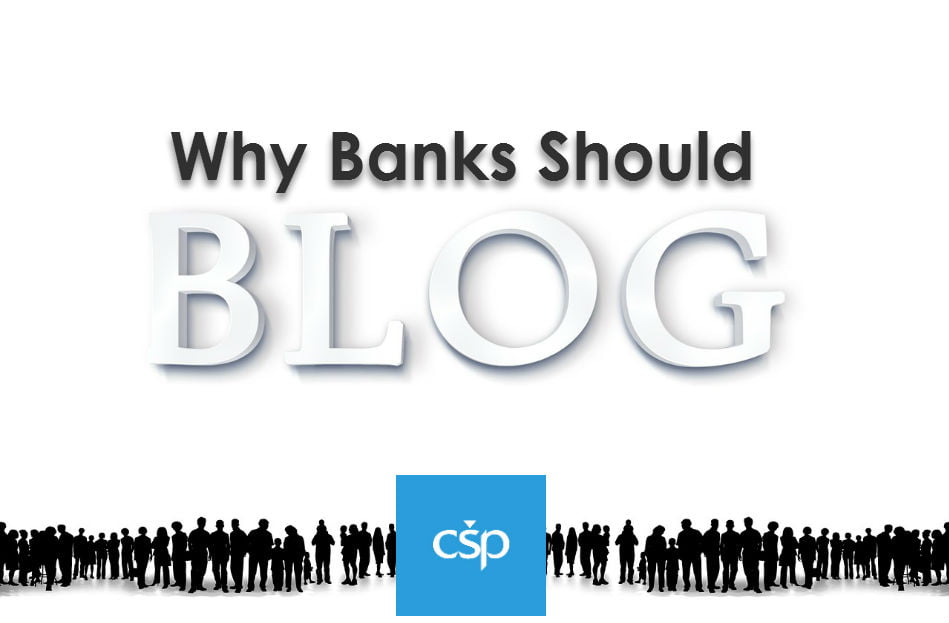It seems like everybody and his brother has a blog these days, including businesses. Some industries are more suited to blogging than others, and financial services is one of those industries. Some banks are already on this bandwagon, but for those who still need some persuading, let us tell you about some of the benefits you might be missing out on.
-
YOU HAVE EXPERTS IN-HOUSE. USE THEM.
Finances, whether personal or business, are hardly self-explanatory. Put your staff’s specialized knowledge and years of experience to work by asking them to contribute content on their particular area of expertise. From basic how-to’s and definitions to explanations of more complicated concepts, your team can contribute directly to your customers’ financial literacy.
-
REINFORCE YOUR VALUE TO YOUR CUSTOMERS.
Every little thing you do to go above and beyond standard service wins you points with your customers. Publishing a blog transforms your bank from a vendor to a valuable resource. It shows your customers you care about their financial well-being, not just your own bottom line. It also gives them a venue to ask you questions – just be careful not to leave those questions sitting unanswered in the comments section.
-
KEEP YOUR SOCIAL MEDIA PIPELINE FULL.
It’s not enough to simply have a social media presence; if you expect your customers to subscribe and stay engaged with you on that channel, you want to feed them a steady stream of fresh, original, valuable content. Blog posts can be used and re-used to keep that pipeline full and balance out any promotional messaging you’re sending out.
-
IMPROVE YOUR SEARCH ENGINE RANKING AND SITE TRAFFIC.
It used to be the case that the only reason any brand started a blog was to stuff it with keywords and attract traffic from search engines. While SEO has evolved beyond keywords since then, Google and other search powerhouses are biased towards websites that are loaded with quality content. Your site is more likely to show up in the results for a search on “home mortgage refinancing” if you’ve published several articles on the topic.
-
CROSS-PROMOTE YOUR PRODUCTS AND SERVICES.
Never miss an opportunity to cross-sell. As you’re writing about any given topic, inline links can point your customers to other pages on your site without distracting from the matter at hand. Online users are used to this kind of linking in news articles, Wikipedia pages, and Tweets, and because it comes across as intuitively relevant, they find it harder to ignore than an intrusive display ad or obvious sales message.
Data-Driven Content Planning
Data isn’t just for setting goals and measuring progress. You can learn a lot about what your customers value and need from both your transactional and Voice of the Customer data. That knowledge feeds directly into your brainstorming if you get it out of the ‘data silo’ trap and integrate it into your content strategy.
What products are your customers using most, and what more could they stand to learn about them? Which ones could use some more time in the spotlight, to increase awareness? What are some frequently asked questions about your branch, your bank, or finances in general? What areas of expertise do you want your institution to be known for? All of these questions are great starting points for a brainstorming session.
Of course, your blog can also be a suitable venue for company news, press releases, and letters from the president, but in terms of value to the customer, informative and entertaining content carries the most weight, and is the most likely to be forwarded and shared.
GETTING STARTED BLOGGING
The two essential ingredients to successful blogging: a plan, and people ready to stick to it.
A blog need not be complicated, and you don’t have to go from 0 to 60 posts a month (!) immediately. But blogs don’t just happen on their own without some planning – topic brainstorming and research, an editorial calendar, and possible production of other multimedia (like infographics or videos).
You also need staff who have both the time and the talent to follow through, both on the production side and the publication & promotion side. If you find yourself short-handed in that department, you could hire freelancers or content-specialized agencies, but remember that no one knows your customers or your business quite like the people who are there every day. (See point No. 1 above.)
Bottom line: Blogging contributes to a well-rounded, holistic customer experience. It positions you as a thought leader, differentiates you from your competitors, and provides additional opportunities for customer engagement. This makes it a natural fit for a bank’s digital strategy.
[“source=csp”]


